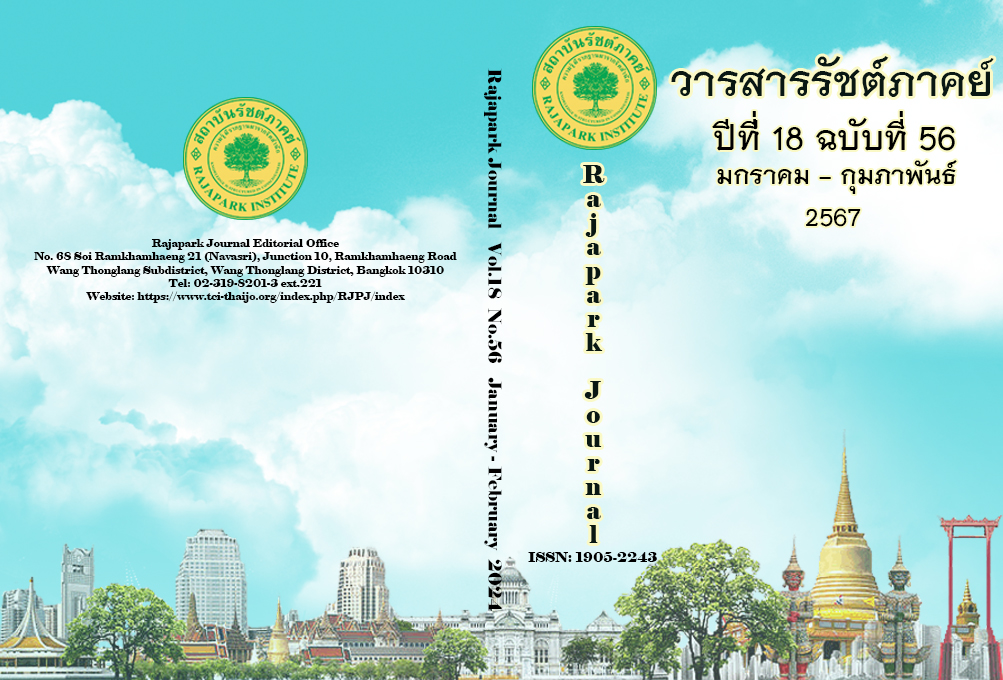การรับรู้การบริหารทรัพยากรมนุษย์อย่างยั่งยืนตามช่วงวงจรชีวิตของพนักงาน กรณีศึกษาบริษัทแห่งหนึ่งในเขตกรุงเทพมหานคร
Main Article Content
บทคัดย่อ
การวิจัยครั้งนี้มีวัตถุประสงค์เพื่อ 1) ศึกษาระดับการรับรู้การบริหารทรัพยากรมนุษย์อย่างยั่งยืนตามช่วงวงจรชีวิตของพนักงาน และ 2) เปรียบเทียบระดับการรับรู้การบริหารทรัพยากรมนุษย์อย่างยั่งยืนตามช่วงวงจรชีวิตของพนักงาน จำแนกตามปัจจัยส่วนบุคคล การวิจัยครั้งนี้เป็นการวิจัยเชิงสำรวจ เก็บรวบรวมข้อมูลโดยใช้แบบสอบถามที่มีค่าความเชื่อมั่นเท่ากับ .931 กลุ่มตัวอย่าง คือ พนักงานในบริษัทแห่งหนึ่งในเขตกรุงเทพมหานคร จำนวน 113 คน สถิติที่ใช้ในการ วิจัยประกอบด้วยสถิติเชิงพรรณนาและสถิติเชิงอนุมานในการทดสอบสมมติฐาน คือ ค่าสถิติทดสอบ T-Test และ One-way ANOVA ผลการศึกษาพบว่า (1) ระดับการรับรู้การบริหารทรัพยากรมนุษย์อย่างยั่งยืนตามช่วงวงจรชีวิตของพนักงาน โดยภาพรวมอยู่ระดับมาก เมื่อพิจารณาเป็นรายด้าน พบว่า ด้านการคัดเลือกพนักงาน เป็นด้านที่มีค่าเฉลี่ยสูงสุด และด้านการพ้นจากการทำงาน เป็นด้านที่มีค่าเฉลี่ยน้อยสุด (2) พนักงานที่มีปัจจัยส่วนบุคคลแตกต่างกัน (เพศ อายุ ระดับการศึกษา รายได้เฉลี่ยต่อเดือน ประสบการณ์การทำงาน และระดับพนักงาน) ในภาพรวม มีระดับการรับรู้การบริหารทรัพยากรมนุษย์อย่างยั่งยืนตามช่วงวงจรชีวิตของพนักงาน ไม่แตกต่างกัน อย่างมีนัยสำคัญทางสถิติที่ระดับ .05
Article Details

This work is licensed under a Creative Commons Attribution-NonCommercial-NoDerivatives 4.0 International License.
ทัศนะและความคิดเห็นที่ปรากฏในวารสาร ถือเป็นความรับผิดชอบของผู้เขียนบทความนั้น และไม่ถือเป็นทัศนะและความรับผิดชอบของกองบรรณาธิการ
References
Bansong, A., Isarankura Na Ayudhaya, W., & Makanong, A. (2019). The Study of the Effectiveness of an Instructional Model based on Social Cognitive Theory and Strategic Life Planning to Enhance Self-Regulation and Health Education Learning Achievement of Lower Secondary School Students in Buriram Province. Journal of Education Studies, 47(2), 345-368.
Bunkomon, P., Sri-amorn, M., Lodkhem, R., & Worawattanaparinya, S. (2017). Factors Influencing the Selection of Operators Level in Automotive Industry, Rayong. Journal of Technical Education Rajamangala University of Technology Thanyaburi, 5(2), 96-107.
Kumwijid, K., & Indusuta, K. (2021). A Study of Conditions and Problems of Personnel Administration by Reference to the Perceptions of Teachers at Tha Maka Performance Promotion Group under Kanchanaburi Primary Educational Service Area Office Two. Journal of Legal Entity Management and Local Innovation, 7(9), 27-41.
Limsritrakul, D., & Yarbara, P. (2019). SMEs with big hearts: How to take care of people to make your business sustainable. Parbpin.
Lu, Y., Zhang, M. M., Yang, M. M., & Wang, Y. (2023). Sustainable human resource management practices, employee resilience, and employee outcomes: Toward common good values. Human Resource Management, 62, 331-353.
Ministry of Labour. (2016). National Human Resource Development Strategy Framework 20 Years (2017-2036 B.E.). Ministry of Labour.
Pechphanand, T., & Punyasiri, S. (2023). Analyzing Structural Equation Model of Work-life Balance, Human Resources Perception, Organizational Citizenship Behavior toward Job Performance in Low-cost Airline Ground Service Staff. Rajapark Journal, 17(53), 67-84.
Phaopat, N. (2021). Opportunities and Challenges in Post COVID-19 Era for Sustainable Human Resource Management and Development. Manpower Potential Development Institute Journal for Eastern Economic Corridor, 1(1), 24-41.
Phoemphian, T. (2019). Employee experience: people management tool. Panyapiwat Journal, 11(3), 306-315.
Samantreeporn, S. (2017). Human Resource Management in the Business Sector in the Rapidly Changing World. Academic Journal Bangkokthonburi University, 6(1), 1-16.
Sama-ae, C. (2019). The Perception of Employees towards the Talent Management System of Rubber Authority of Thailand, Trang Province[Master's thesis, Prince of Songkla University].
Savitz, A. W., & Weber, K. (2013). Talent, transformation, and the triple bottom line: how companies can leverage human resource to achieve sustainable growth. John Wiley & Sons.
Sublai, N., & Hengsadeekul, V. (2019). The Relationship of Human Resource Management with the Effectiveness of Job Performance and Loyalty of Employees in Operational Level, Real Estate Business in Samutsakorn Province. SAU Journal of Social Sciences & Humanities, 3(1), 89–109.
Thongsaptawee, K. (2021). Personnel Perception towards Strategic Planning at Rajamangala University of Technolgy Thanyaburi [Research report, Rajamangala University of Technolgy Thanyaburi].
Wetprasit, W. (2021). The Model of Green Human Resource Management Strategy Affecting the Sustainable Performance of Environmentally Friendly Enterprises in Thailand. Srinakharinwirot Business Journal, 12(1), 57-79.
Yamane, T. (1973). Statistics: An Introductory Analysis. Harper & Row.
Yong, J. Y., Yusliza, M., Ramayah, T., Jabbour, C. J. C., Sehnem, S., & Mani, V. (2019). Pathways towards Sustainability in Manufacturing Organizations: Empirical Evidence on the Role of Green Human Resource Management. Business Strategy and the Environment, 1–17.

